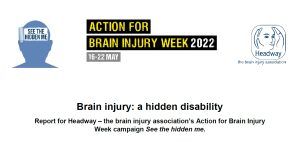Headway’s Action for Brain Injury (ABI) week was held from 16 – 22 May 2022. This year’s campaign focussed on what can be for many brain injury survivors, a hidden disability. The campaign – See the Hidden Me – raised awareness and understanding of an often misunderstood symptom of brain injury, and worked to alleviate the challenges and frustrations that survivors face.
The campaign aimed to give a voice to survivors so friends, families, colleagues and professionals gain a better insight into the invisible battles they may face every day.
To help shape the campaign and better understand the experiences of brain injury survivors, Headway launched a survey in February 2022, the results of which were published as part of ABI week. The survey was designed to be completed by brain injury survivors and their carers and intended to help raise awareness and understanding of the issues that matter the most. Members of Headway North Cumbria were invited to contribute to the survey.
 The survey was completed by 2,682 respondents across the country, providing a large enough sample to gain an accurate picture of the emotions and challenges of living with a hidden disability.
The survey was completed by 2,682 respondents across the country, providing a large enough sample to gain an accurate picture of the emotions and challenges of living with a hidden disability.
The key findings were:
-
More than half (55%) of brain injury survivors feel they have been unfairly treated as a direct consequence of their brain injury being hidden
-
Two thirds of friendships (67%) and more than half (55%) of relationships with a spouse/ partner have been negatively affected as a direct consequence of the brain injury being hidden
-
9 out of 10 (86%) of people affected by brain injury (survivors and carers) felt that a lack of understanding from society is one of the main challenges to living life with a hidden disability


Further details, including videos from brain injury survivors, can be found at the Headway UK website – See the Hidden Me.
The full survey report can be found here or by clicking on the image below.
At our Day Centre session on 16 May 2022 Headway North Cumbria members were invited to be creative by decorating face shields with stickers of injured and tired brains as a means of making the disability less hidden and expressing how a brain injury made them feel. We also encouraged our members to discuss the issues associated with living with a hidden disability.




